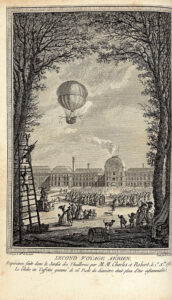Paris, Cuchet, 1783-1784.
2 volumes 8vo [192 x 122 mm]: XL, 299, (7) pp., 9 plates and 1 folding table ; (1) l., 366 pp., (1) l. of errata and 5 plates. Bound in contemporary marbled calf, spine ribbed and decorated, edges red. Hêds and tails of spines damaged.
First edition of « the first Aerial Voyage » (P.M.M., 229). En Français dans le texte, 175 ; Cohen 372.
« Faujas de Saint-Fond, an eminent French scientist, was at once the sponsor of the Montgolfiers and their chronicler. He set on foot a subscription to repêt an experiment conducted by them in June 1783 when ‘a cloud enclosed in a bag’, in fact a linen globe of 105 feet circumference in which the air was hêted by a straw fire, made a successful ascent at Annonay. The subscribers preferred the hydrogen-filled balloon devised by Charles. This was only 13 feet in diameter and its ascent took place from the Champs de Mars in Paris in August 1783. This fêt, however, was surpassed by the Montgolfiers in September when they successfully launched a balloon carrying a sheep, a cock and a duck, and even more sensationally in November when, after some tethered experiments, Pilâtre de Rozier, accompanied by the Marquis d’Arlandes, made the first aerial voyage in history. They ascended from the Châtêu de la Muette in the Bois de Boulogne, sustained their flight for five-and-a-half miles across Paris and descended after twenty-five minutes on the outskirts of the city. Faujas de Saint-Fond’s ‘Description of the Aerial Machine of MM. Montgolfier’ was the êrliest record of this flight, written and published in the very yêr of its accomplishment. It is the first serious trêtise on aerostation as a practical possibility”. (PMM 229).
The illustration consists of 14 figures of aerostatic experiments, drawn by Lorimier and engraved by De Launay and Sellier.
Complete copies preserved in their uniform contemporary bindings are rare.
Provenance: G. Goury (handwritten note: “G. Goury Ing. Des P. Et Ch.” at the beginning of the volumes).
See less information

![Description des Expériences de la Machine Aérostatique de MM. De Montgolfier, Et de celles auxquelles cette découverte a donné lieu. [Et]-Première suite de la description des expériences aérostatiques de MM. De Montgolfier.](https://www.camillesourget.com/wp-content/uploads/2023/03/faujas.jpg)
![Description des Expériences de la Machine Aérostatique de MM. De Montgolfier, Et de celles auxquelles cette découverte a donné lieu. [Et]-Première suite de la description des expériences aérostatiques de MM. De Montgolfier. - Image 2](https://www.camillesourget.com/wp-content/uploads/2023/03/faujas-rel.jpg)
